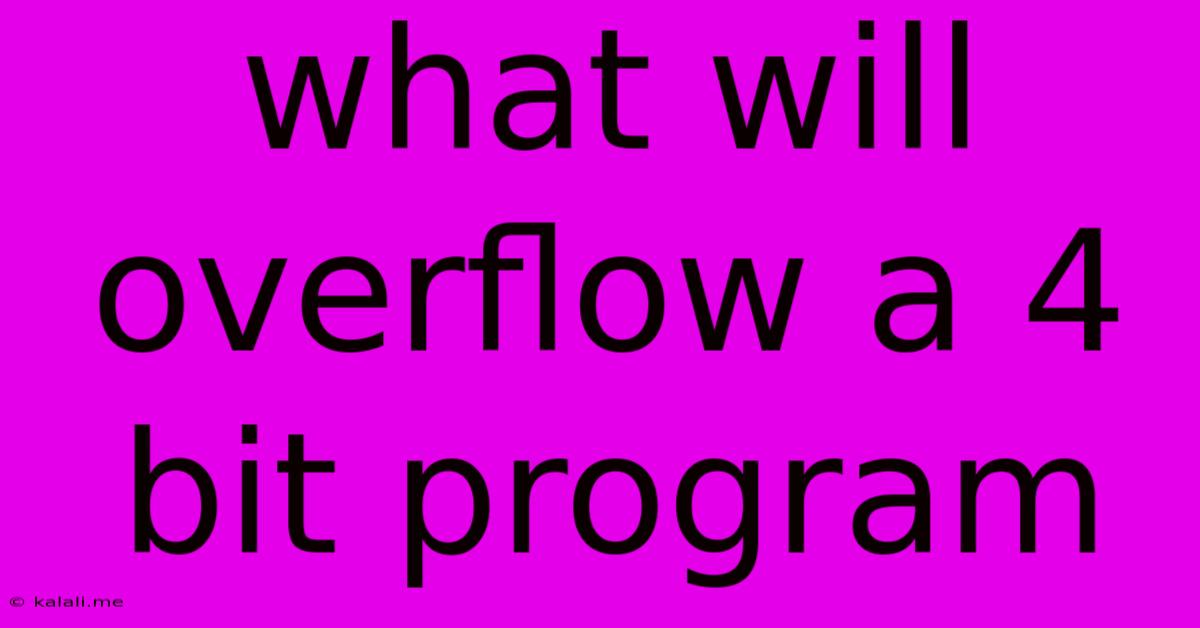What Will Overflow A 4 Bit Program
Kalali
Jun 03, 2025 · 3 min read

Table of Contents
What Will Overflow a 4-Bit Program? Understanding Integer Overflow
This article explores the concept of integer overflow, specifically within the context of a 4-bit system. We'll delve into how it occurs, its consequences, and provide practical examples to solidify your understanding. Understanding integer overflow is crucial for programmers working with embedded systems, low-level programming, or any situation where memory constraints are a factor.
What is Integer Overflow?
Integer overflow happens when you try to store a numerical value in a variable that's too small to hold it. In simpler terms, it's like trying to pour a gallon of milk into a pint-sized glass – some milk will inevitably spill over. In a computer program, this "spillage" leads to unexpected and potentially problematic results. A 4-bit system can only represent 2<sup>4</sup> = 16 distinct values (typically 0-15 in unsigned representation, or -8 to 7 in signed representation). Attempting to store a number larger than the maximum representable value results in overflow.
Overflow in Unsigned 4-Bit Integers
In an unsigned 4-bit system, the range of representable numbers is 0 to 15. Adding 1 to 15 results in an overflow. Let's illustrate this:
- 15 (binary 1111) + 1 = 0 (binary 0000). The carry bit is lost.
Any arithmetic operation that produces a result exceeding 15 will cause an overflow in this context. For example:
- 10 + 7 = 17, which overflows to 1.
- 12 + 6 = 18, which overflows to 2.
These seemingly incorrect results stem directly from the limited capacity of the 4-bit register. The most significant bit is discarded, leading to a "wrap-around" effect.
Overflow in Signed 4-Bit Integers
Signed 4-bit integers use one bit to represent the sign (positive or negative). The range becomes -8 to 7. Overflow can occur in two ways:
- Positive Overflow: Adding a positive number to a positive number that results in a value greater than 7. For example, 5 + 4 = 9, which overflows to -7.
- Negative Overflow: Subtracting a positive number from a negative number that results in a value less than -8. For example, -8 - 1 = -9, which overflows to 7.
Consequences of Integer Overflow
The consequences of integer overflow can be severe, ranging from subtle errors to complete program crashes. They often manifest as:
- Incorrect calculations: The most obvious consequence. Results are simply wrong.
- Unexpected program behavior: Overflow can lead to unexpected jumps in program flow, potentially executing unintended code sections.
- Security vulnerabilities: In some cases, malicious actors can exploit integer overflow vulnerabilities to gain unauthorized access or manipulate program behavior. This is a significant concern in security-sensitive applications.
- System instability: In extreme cases, integer overflow can lead to system crashes or data corruption.
Avoiding Integer Overflow
Several strategies can help mitigate the risk of integer overflow:
- Careful data type selection: Choose appropriate data types that can accommodate the expected range of values. If dealing with potentially large numbers, use larger data types like 8-bit, 16-bit, or even larger integers.
- Input validation: Validate user inputs to ensure they fall within the acceptable range before performing calculations.
- Range checking: Implement code to explicitly check for potential overflow conditions before and after arithmetic operations.
- Using saturation arithmetic: Instead of wrapping around, saturation arithmetic clamps the result to the maximum or minimum representable value when an overflow occurs.
Conclusion
Understanding integer overflow is paramount for creating robust and reliable software, especially in resource-constrained environments. By carefully considering data types, implementing input validation, and employing appropriate error handling techniques, developers can effectively prevent and mitigate the risks associated with integer overflow. Remember, the 4-bit example illustrates a fundamental concept applicable to any system with finite integer representation.
Latest Posts
Latest Posts
-
How Man Postgres Connection Are Good
Jun 05, 2025
-
How Do You Pronounce S U B T L E
Jun 05, 2025
-
Factorio How To Put Sometihg In Front Of Queue
Jun 05, 2025
-
Can You Use Rice Vinegar Instead Of White Vinegar
Jun 05, 2025
-
How Many Years Is 14 Generations
Jun 05, 2025
Related Post
Thank you for visiting our website which covers about What Will Overflow A 4 Bit Program . We hope the information provided has been useful to you. Feel free to contact us if you have any questions or need further assistance. See you next time and don't miss to bookmark.